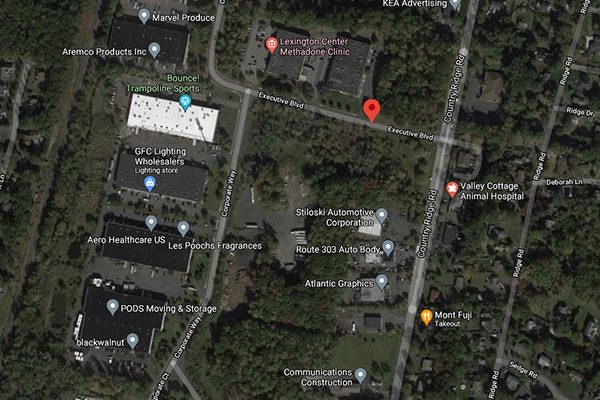|
RCBJ-Audible (Listen For Free)
|
Applicant Asking Town To Change Zoning Code To Allow 50-Foot Warehouses Townwide
By Tina Traster
A New Jersey distribution center developer is proposing to build a 220,000 square-foot industrial warehouse on 20 acres in Clarkstown Executive Park on Route 303 in Valley Cottage. The applicant, which purchased several properties in the corporate park in April, is asking the Town of Clarkstown to change its zoning code to allow 50-foot-high warehouses in commercial/office zones townwide.
A change in the zoning code would affect every C/O zoned property in the town. The current designation allows for 40-foot buildings. The applicant alternatively is asking for a variance for just its property to exceed the height limit. Existing buildings in the corporate park range in height from 20 to 32 feet.
The applicant writes that “50-foot-high buildings is consistent with modern warehouse facilities to serve the market and a building of that height is not incongruous with the intent of the zone, the Master Plan, or the neighborhood where the property” is situated.”
Lincoln Equities of Rutherford, NJ, which builds and owns distribution centers in New Jersey, Connecticut and Long Island, hopes to develop a warehouse that would be used for companies like Amazon, UPS, and Fedex that store and distribute goods.
With everybody wanting everything delivered “yesterday”, this type of distribution/fulfillment center is among the hottest trend in commercial real estate development. Other towns in the Hudson Valley facing similar development pressure have imposed limitations on operating hours, required the installation and maintenance of air quality monitors, and stepped-up local enforcement of idling laws. There are at least two schools, Valley Cottage Elementary and St. Paul Catholic, in close proximity to the proposed project, as well as Clarkstown’s Gilchrest Town Park.
In addition to the 220,000-square-foot building, the applicant is seeking 250 employee parking spaces, 54 loading berths, and 53 tractor-trailer parking spaces.
The proposed warehouse would sit on a 20-acre vegetation-covered site with wetlands, easements, and steep slopes. Due to these environmental issues, the applicant can only use 17.9 acres to calculate its development potential.
The town code limits land disturbances for up to five acres at a time; the developer is seeking a waiver because its proposed building footprint exceeds the five-acre threshold. The developer presented the plan to Clarkstown Technical Advisory Committee (TAC) last week. Town officials did not seem to raise concerns about the applicant needing the waiver.
With only one access in and out of Clarkstown Executive Park, truck traffic leaving the warehouse will spill onto state road Route 303, a single-lane byway. This traffic will likely head south toward the New York State Thruway passing through residential and shopping districts.
According to the developer’s proposal Langan Engineering, traffic generated by the project is minimal, estimating an additional seven trucks to weekday morning peak traffic and eight to the afternoon rush hour. The report does not take into consideration the 24-7 nature of logistics warehouses.
The traffic study analyzed four intersections: three of which are within the boundaries of the corporate park. The fourth intersection is Route 303 and Executive Boulevard.
Lance Bergstein, Acquisitions Officer with Lincoln Equities, in commenting on the acquisition of the portfolio, has said “we see upside in the adjacent land which will help meet user demand in an underserved, last-mile logistics location.”
The applicant prepared a report based on a study by the Institute of Transportation Engineers (ITE) in a publication called “Trip Generation Tenth Addition.” In categorizing itself as general warehousing, the ITE estimates .19 trips per 1,000-square feet of gross floor area (GFA), which would generate roughly 40 trips during pm peak hours – far more than the eight it projects.
The ITE report has a list of categories such as fulfillment center warehouse and “parcel hub” warehouses, which range from .64 trips per 1,000-square-feet of GFA to 1.37 trips per 1,000-square feet of GFA.
But given the size of the proposed warehouse and its number of berths, the applicant is perhaps more accurately categorized as either a fulfillment center warehouse or a parcel hub warehouse. According to the ITE, these facilities generate between .64 and 1.37 trips per 1,000 square feet. At 220,000 square feet, give or take, the number of trips is closer to 128 to 275 truck trips during peak hours.
The town has determined that the application is a “Type-1 SEQRA”, which means it will be subject to a full environmental review before the Planning Board. Environmental issues might include noise from a 24/7 operation, diesel exhaust and the release of particulate matter from idling and operating trucks, air quality monitoring, and the potential restriction on operating hours.










